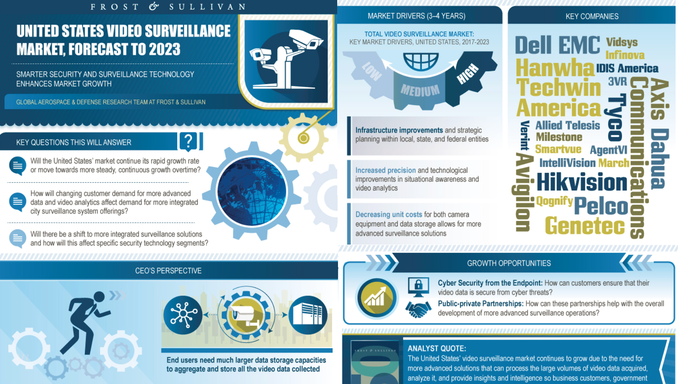
by Brianna Crandall — December 11, 2017 — The US video surveillance market is set for growth, according to a new report from global growth partnership company Frost & Sullivan. Infrastructure improvements and strategic planning within local, state, and federal entities, coupled with increased precision, smart security, and surveillance improvements in situational awareness and video analytics, are key factors propelling an estimated $6,439.0 million in spending until 2023.
Retail and commercial, city surveillance, and critical national infrastructure will see the largest overall segment growth. Security solutions that can offer more system automation capabilities, machine intelligence, real-time event management, and reporting will appeal to all end-users as a way to enhance surveillance operations while providing real-time business intelligence for operational decisions.
Frost & Sullivan’s research provides an in-depth analysis of key market dynamics, including drivers, restraints, forecasts, trends, market share, and competitive profiles. Technology trends such as cameras, video analytics, video management systems, and video storage are discussed, with end-user vertical assessments of city surveillance, airport, traffic and transit, critical national infrastructure, and retail and commercial.
Frost & Sullivan Security Industry Analyst Danielle VanZandt stated:
End users are demanding converged, end-to-end solutions and access to system integration when doing major surveillance system overhauls. They are choosing technologies that merge seamlessly with one another while providing a variety of analysis and real-time event management functions. To remain competitive, vendors should offer a comprehensive, integrated surveillance system in a complete system suite, rather than a standalone analytics, VMS, or storage option.
Key findings driving the United States video surveillance market growth include:
- High growth in analytics technologies due to increased accuracy, maximum efficiency, and ease of integration with new and legacy security;
- Customers moving from on-premise-only storage solutions to hybrid on-premise/cloud options or switching to cloud-only storage solutions due to volume of video data gathered;
- Lower costs for cameras and video storage hardware;
- Customer interest in analytics technologies that can automatically alert or execute security actions upon analysis; and
- Increased public safety initiatives and commercial security practices creating opportunities in both the government and commercial markets.
VanZandt noted:
End-users in all industry verticals remain constrained by limited budget allocations and strict upgrade schedules, causing them to delay improvements or replace faulty equipment rather than upgrade to more advanced systems. Converged security systems, which allow for modular upgrades and system integration phases, will appeal to end-users with limited budgets and those who must adhere to these schedules.
The United States Video Surveillance Market, Forecast to 2023, report, part of Frost & Sullivan’s Security Growth Partnership Service program, is available to purchase from the Frost & Sullivan Web site.





